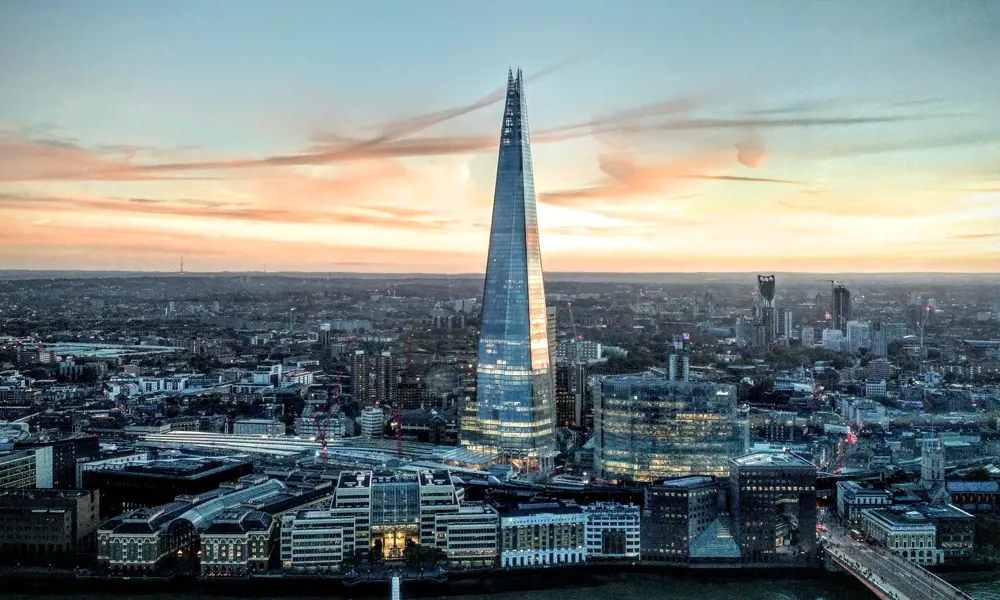
Building the Shard
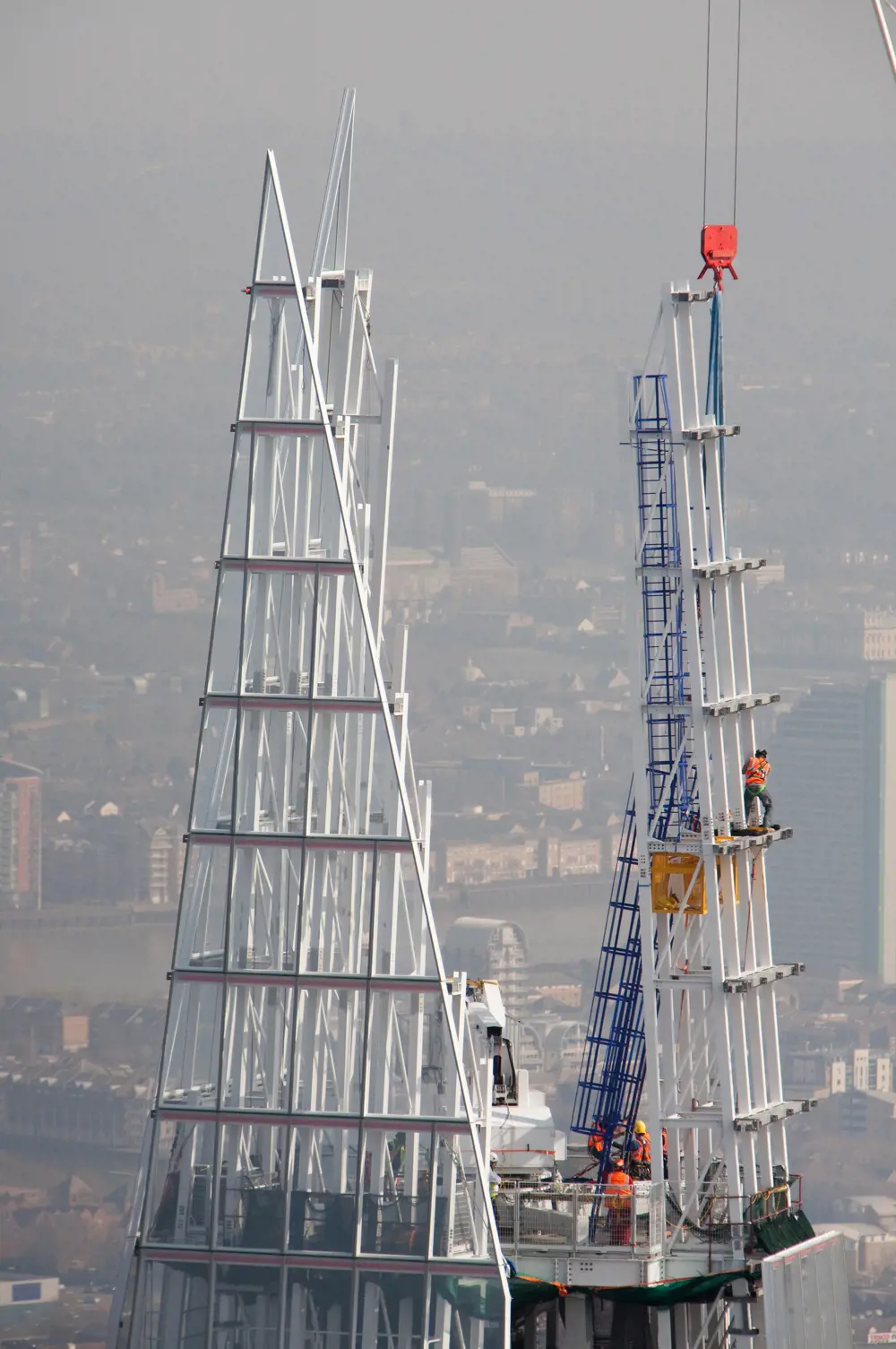
The last piece of steel being lifted into place on The Shard’s spire in March 2012 © Mace/Sellar
The Shard was conceived in 2000 by Renzo Piano at the behest of London-based entrepreneur Irvine Sellar, to be built on the land occupied by Southwark Towers, an office-block Sellar owned and wanted to replace. Like all London skyscrapers, The Shard quickly gained a nickname, which has since also become its formal name. The name ‘The Shard’ is derived from master architect Renzo Piano’s description of the development as a ‘shard of glass’ during planning stages.
In late 2007, the uncertainty in global financial markets sparked concerns about getting The Shard’s construction started. The project was almost cancelled, but in January 2008, it was announced that a consortium of Qatari investors had paid £150 million to secure an 80% stake in the project. Building work started in 2009 and was completed in 2012. The Shard’s 95 storeys is now home to a 200-bed 5-star hotel, three floors of restaurants, 10 residences, and a public viewing platform.
Visually, The Shard’s most striking features are its 310m height and the glass which forms its sloping walls and gives the structure its name. Less obvious but equally impressive is the use of the latest structural engineering tools and techniques to optimise every aspect of the structure, from the foundations to the shard tips.
One of the most impressive innovations was the bold and imaginative use of ‘top-down’ construction which allowed the first 23 storeys of the concrete core and much of the surrounding tower to be built before the basement beneath it had been fully excavated.
Top-down is not an innovation in itself: it was used to build the new parliamentary office building, Portcullis House, in Westminster in the 1990s while excavating for the Jubilee line Underground station beneath. But using the technique for the core of a very tall building was a world first. By cutting three months off the construction programme, carried out by Mace, it enabled substantial savings to be made and kept the cost down to under £450 million.
The bold and imaginative use of ‘top-down’ construction allowed the first 23 storeys of the concrete core and much of the surrounding tower to be built before the basement beneath it had been fully excavated.
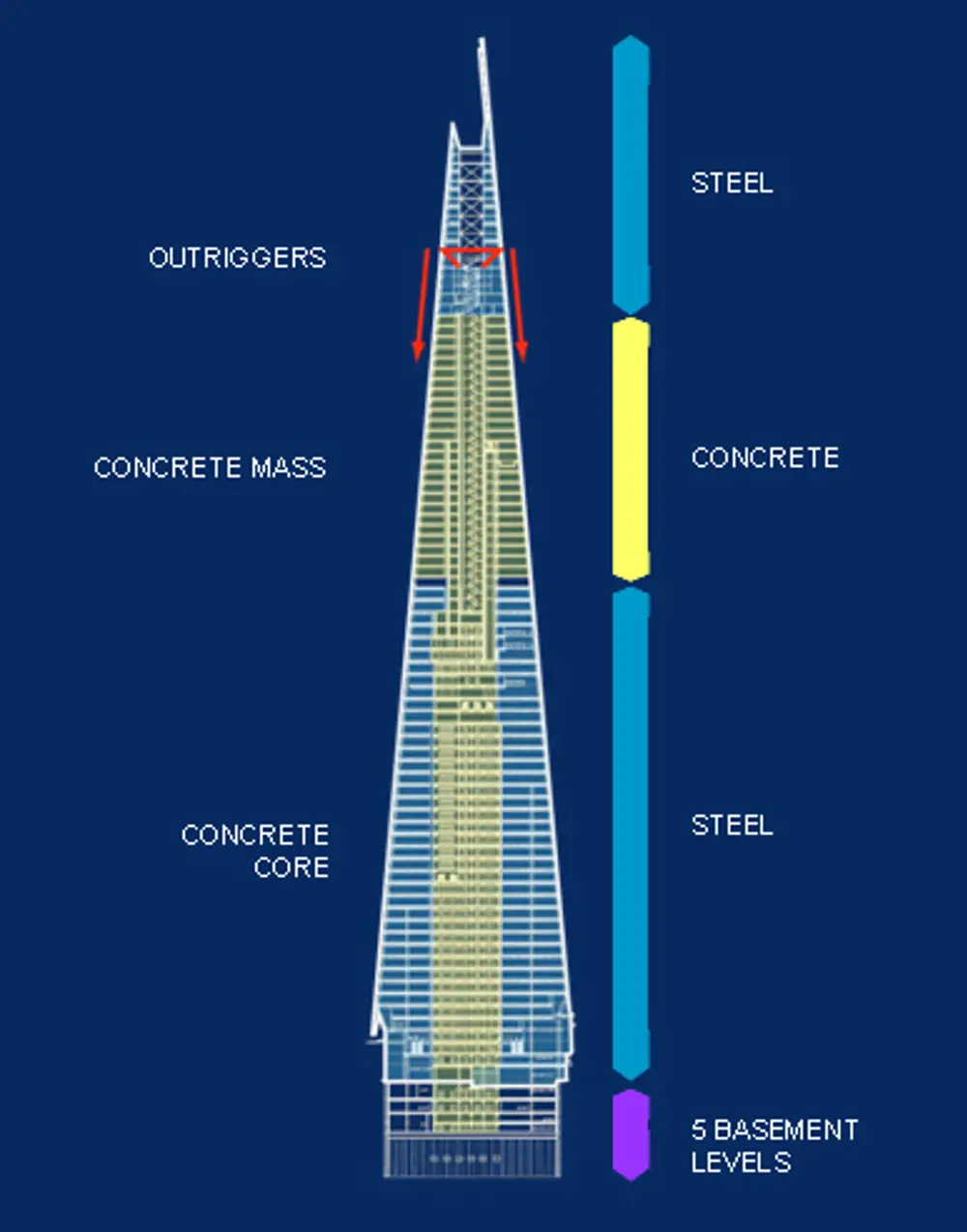
The Shard is a hybrid structure: concrete in the basement, steel to level 40, concrete again to level 69 and finally a steel ‘spire’ at the top © WSP
Narrow margins
This super-tall building has been developed within a confined site area. Sandwiched between London Bridge station and Guy’s Hospital, a 24-storey 1970s concrete-framed office block had to be removed piece-by-piece before construction work could start.
Structural engineers calculated that this removal of 25,000 tonnes of concrete and glass could cause the ground to ‘relax’, with the potential to cause movement to nearby structures.
A finite element analysis of the soil and soil-structure interaction was performed to assess the heave and settlement effects during demolition and subsequent construction. These revealed a zone of influence extending about 70 m outside the perimeter, and an extensive monitoring system was put in place. At the demolition stage, there was less than 5 mm movement measured of the adjacent Jubilee line tunnel and there was no more than 12 mm during the whole course of the project.
Unlike the building it replaced, The Shard occupies virtually every square metre of the site, with no surrounding space for storage. Pre-planning was an essential requisite throughout the four-year build in this built-up commuter area.
The old building’s large concrete under-reamed piles, for example, were not deep enough to use on the new building, and were too difficult to remove or to drill through – both in terms of time and cost of jackhammering out all the concrete. The answer was to arrange the new piles in a pattern which avoided the old.
With the demolition over, a perimeter wall was created round the edge of the site by sinking interlinked secant piles – closely-spaced bored piles used to form a retaining wall. The ground floor slab was then cast, with a hole left for the core to pass through, in order to act as a prop for the wall ahead of excavation beneath.
Controlling the sway
🌬️ How engineers ensured building inhabitants at the top wouldn't feel the effects of 100 mile per hour winds
All tall buildings move in the wind, and gusts of 100 miles per hour have been recorded near the top of The Shard. What the occupiers will notice is not the movement itself – in The Shard’s case, up to around 300-400 millimetres at the top – but the horizontal acceleration as the building sways back and forth, and this was particularly important in the hotel and residential section. A limit of just 0.15 metres per second at level 65 was placed on the design, and achieving this required a combination of damping the oscillations (provided, conveniently, by the heavy concrete section between levels 41 to 69) and increasing stiffness.
The stiffness was increased by WSP with a ‘hat truss’ at level 66. This uses outrigger struts rising diagonally from the perimeter columns to the central core, with the sole purpose of reducing the lateral acceleration. But tightening the bolts on the truss had to be left until near the end of The Shard’s construction.
This was because buildings shorten during construction – through foundation settlement, elastic compression of materials and (with concrete) shrinkage and creep. For a building up to around 15 storeys, the effects are negligible but with The Shard they are substantial, and they vary across the building: the perimeter columns have shortened much more than the core. This meant many additional deflection calculations for various stages of construction using ETABS structural analysis software, and considerable extra complications in construction: floors, for example, had to be built slightly off the horizontal so that they would settle into the correct position. And only once the building was complete and most of the shortening had taken place could the hat trusses be finally fixed.
Shard concept
The Shard is an unusual mixture of concrete and steel, a tiered wedding cake of a building with a concrete basement, structural steel from ground to level 40, concrete from levels 41 to 69, and steel again from there to the top at level 95. The whole structure is given stability by a massive concrete core that is placed in the middle of the building.
This design solution was driven by the intended use of The Shard, but its side effects have been to improve the dynamics of the building, save money and add lettable space – see Controlling the sway. The lower floors of the structure were designed to be offices, with spans of up to 15 m from perimeter to core. Structural steel columns and beams were the optimal solution for these floors, with plenty of space between the deep beams for the extensive services required.
In the upper part of the building, the use changes to hotel and residential accommodation, where fewer ceiling-mounted services are required and where acoustic separation of the floors becomes much more important. The tapering of the building here means that the maximum span at this height is down to 9 m. Concrete columns and post-tensioned concrete flat slabs were the best solution on these floors. And then by reducing the storey height in this section from 3.75 m to 3.1 m it was possible to include two extra floors – an important consideration since the overall height was limited by the Civil Aviation Authority.
Excavating while building
With the perimeter wall built and the ground floor slab cast, concrete piles were sunk to support the building, the largest piles being underneath the core and extended down as far as 53 m. Massive steel plunge columns were then embedded in the top of the piles, rising up to above B2 level. The building (and particularly, the core) could then start to rise upwards, supported on the plunge columns, while excavation of the basement proceeded underneath.
With excavation complete, the B3 basement slab, the bottom of the building, was ready to be cast. Here, the engineers worked hard to design the slab to be as thin as possible, both to save unnecessary excavation and to avoid the complications of deepening the secant pile walls. The result was a remarkably thin slab by comparison with similar sized buildings elsewhere in the world.
Nevertheless, at 3 m thick under the core with four layers of reinforcement in each direction, this was a massive slab, requiring the UK’s largest ever continuous concrete pour: three concrete pumps placed 700 truckloads over 36 hours, a total of 5,500 m3.
The concrete used ground-granulated blast furnace slag – a byproduct of steelmaking – as a substitute for 70% of the Portland cement. The slag has a much lower carbon footprint, eliminating 700 tonnes of CO2 emissions in the base slab alone while at the same time giving off less heat as it cures. Even so, the temperature of the base slab reached more than 60°C during curing.
With the base slab in place, the missing section of the core walls between the bottom of the core and the B3 slab could be cast. By the time that the core was at last resting on its final foundations, the building above had risen 23 storeys.
The spire: topping off the Shard
🤯 OR: assembling a 23-storey building 300 metres in the air... with wind speeds of 100 miles per hour
At the top of The Shard sits the steel and glass spire. Containing just 530 tonnes of The Shard’s total weight of 12,500 tonnes of structural steel, it is light compared with the remainder of the building, but at 60 m and 23 storeys high, it is a significant building in its own right. In addition, It had to be assembled 300 metres up in the air, over the top of the highest point of the concrete core, where winds can reach speeds of 100 miles per hour.
This was never going to be easy, and there were concerns about how to construct it safely and without delays. The architect recognised that the spire would be the focal point of the whole building and so he wanted it as perfect as possible.
The solution was to minimise work at height by pre-assembling the spire in modules, in a two-stage process. First the steelwork, with flooring added, was built in segments up to 3 metres wide, just small enough to fit on 3 metre-wide trailers for transport to site. Once on site, segments were bolted together to get as close as possible to the 7.5 tonne limit of the tower crane, thus reducing the number of crane lifts from 800 to only around 100.
And to be sure that it could all be done ‘right first time’, it was decided first to do a dry-run of the process, assembling the whole spire in three-storey sections in steelwork contractor Severfield Rowan’s Yorkshire works. This enabled any risks or difficulties to be identified before final assembly, and also allowed the architect to make adjustments to the appearance, for example by improving the quality of the welding where the finish would be visible. The modularisation and test erection paid off, as crane lifts for the highest levels were severely restricted by high winds during the build phase.
Building upwards
Slip-forming the core – pouring the concrete almost continuously while sliding the formwork continuously up the building – has now become a conventional technique; in The Shard’s case this was done at the rate of 3 m a day. For the tricky task of steering the slip-form to achieve an accuracy of ±25 mm in the position of the core, the contractors tried both GPS and more conventional laser guidance. To most people’s surprise, the GPS produced more consistent results.
Buildings usually have some form of symmetry or regularity which can aid design and construction. By contrast, The Shard is an irregular pyramid with highly complex geometry, governed largely by the irregular shape of the site. The tower has 18 facets – a combination of large planes of glass and narrow re-entrant ‘fractures’ in between – together with a 19-storey extension, or ‘backpack’, attached to the eastern side. And because The Shard tapers as it rises, every floor plate is different. This presented plenty of design challenges requiring rigorous analysis and extensive use of 3D modelling.
Up to level 40, the structure has steel columns and steel beams supporting composite steel floors consisting of steel plate with a 130 mm layer of concrete on top. From level 41, concrete columns support post-tensioned concrete floors just 200 mm thick. With fewer ceiling-mounted services needed in the hotel and residential sections, the storey height could be lowered with most of the services confined to the edge of the floor plate. The top section, the spire, reverts to steel with composite steel floors – see Preassembling the spire.
The tapering of the building creates a series of challenges for the design of the perimeter columns, both to ensure effective transfer of loads and to avoid unsightly detailing. By and large, these perimeter columns slope with the face of the building, but in places they ‘kink’ towards the vertical, creating horizontal forces that have to be transferred back to the central core through the floors.
The perimeter columns are designed so that their weight, size and spacing reduce with the height of the building, adding to the effect of an increasingly delicate structure tapering into the sky: spacing varies from 6 m at the base to 3 m in the hotel section to 1.5 m in the spire. Where the changes occur, transfer structures are needed and these have been ‘hidden’ in the façade. To avoid deep beams round the perimeter, loads were transferred using three-storey deep vierendeel trusses (frames with fixed joints that are capable of transferring and resisting bending pressures).
Mace, the construction company building The Shard, aimed for continuous improvement in safety through the project. Risks were highlighted on design drawings and details were amended so that these areas were safer to construct. The edge beam in the steel levels, for example, was fabricated with floor decking, edge trim, façade brackets and edge protection already in place so that less work was needed at height in this hazardous area. An ‘empty pockets’ policy was introduced to reduce the risk of falling objects. Throughout the build there were no major incidents, but the minor incidents were investigated thoroughly in order to learn lessons and prevent recurrence.
The ‘shards’ are triple-glazed, with a naturally ventilated cavity between the external glazing and the double-glazed units on the inside. Solar gain is reduced by blinds within the cavity, which are driven down automatically when necessary by the building maintenance system. The outside windows are cleaned via building maintenance units at levels 29, 75 and 87 – nine in all. These units have multi-jointed arms that can reach around the building and lower cradles to all parts of the façade.
Construction of The Shard hit its first target of ‘visual completion’ in time for the London Olympics. Fit-out continued with completion of the tower’s 44 lifts, some double-decked and some stacked over each other to serve just part of the tower. The three-storey-high viewing gallery on levels 69 to 71 opened in 2013, followed soon after by the five-star, 200-plus bedroom Shangri-La hotel. Then all that was needed was tenants to occupy the offices, and owners for the spectacular apartments at the top of The Shard.
Reaching new heights
Getting workers and materials up to the top of The Shard during construction, without delaying the high-speed programme and in all kinds of weather, was particularly challenging for the design and construction team, and prompted some unique solutions.
Gaining access to the lower floors was relatively straightforward with four tower cranes round the edges of the site doing most of the heavy lifting. When the building reached 162 m, the cranes had come to the limit of their reach and new cranes were called for.
First, a tower crane was attached to the rig that rose steadily up the building with the slip form – the moving formwork. This is believed to be the first time the technique of attaching a crane to the slip form has ever been tried outside North Korea, where it failed due to the difficulties of keeping the crane stable. Here, stability was successfully achieved by extending the lower section of the tower crane down into one of the already-cast lift shafts where guide rails kept it vertical.
For the top section of the building, the central crane would have been in the way. So a new tower crane was erected outside the building envelope, cantilevering off the concrete core – the first time such a technique had been used outside the US, and at 317 m, the UK’s highest ever crane. This made a dramatic sight on the London skyline, as the tapering building moved further away from the crane as it progressed upwards (see diagram)
With the external construction complete, there came the inevitable conundrum: no crane can lower itself to the ground. A ‘recovery crane’ was erected by the cantilevered tower crane, which was then dismantled and lowered by the recovery crane. Then a smaller, spider crane was taken up the jump-lift in pieces, assembled, and taken down the same way after lowering the recovery crane in pieces.
***
This article has been adapted from "Building the Shard", which originally appeared in the print edition of Ingenia 52 (September 2012).
Contributors
John Parker is a Technical Director for WSP’s London structures team. He has worked on Hungerford Bridge, the Jubilee Line Extension and London Bridge station projects as well as The Shard. He is particularly interested in enhancing architecture through expressed structural engineering.
Keep up-to-date with Ingenia for free
SubscribeRelated content
Civil & structural
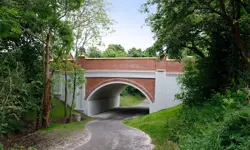
FlexiArch
Arch bridges are strong, durable and require little maintenance. However, very few had been built since the early 1900s until the FlexiArch was developed and launched in 2007. Now, there has been a minor renaissance for this ancient form of construction.

Creating user-friendly buildings
For Michelle McDowell, a former Business Woman of the Year, a passion for joined-up design thinking and building information modelling with a user-friendly approach has enabled her to pioneer revolutionary changes in her field.

Troja Bridge
In November 2014, one of the world’s largest network arch bridges was officially opened in Prague. The UK may soon have its first network arch bridge if the go-ahead is given for a new rail project in Manchester.
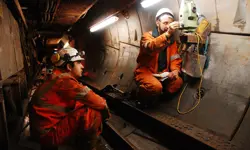
Tunnel boring navigation
With no surface reference points, underground surveying requires specialised skills in order to gain trustworthy accuracy for the surveying team. Find out what techniques are used to measure distance, maintain position and cope with curved alignments in tunnels.
Other content from Ingenia
Quick read

- Environment & sustainability
- Opinion
A young engineer’s perspective on the good, the bad and the ugly of COP27

- Environment & sustainability
- Issue 95
How do we pay for net zero technologies?
Quick read

- Transport
- Mechanical
- How I got here
Electrifying trains and STEMAZING outreach

- Civil & structural
- Environment & sustainability
- Issue 95